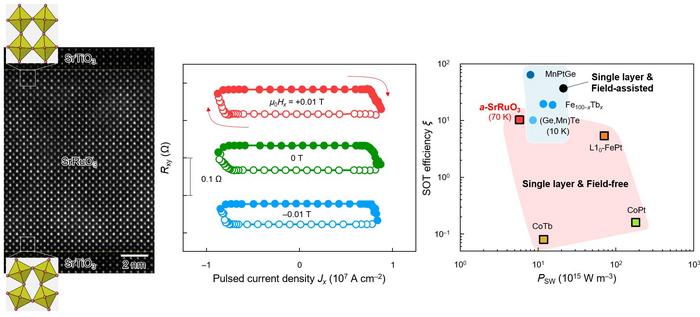Like the flutter of a butterfly’s wings, sometimes small and minute changes can lead to big and unexpected results and changes in our lives. Recently, a team of researchers at Pohang University of Science and Technology (POSTECH) made a very small change to develop a material called “spin-orbit torque (SOT),” which is a hot topic in next-generation DRAM memory.

Credit: POSTECH
Like the flutter of a butterfly’s wings, sometimes small and minute changes can lead to big and unexpected results and changes in our lives. Recently, a team of researchers at Pohang University of Science and Technology (POSTECH) made a very small change to develop a material called “spin-orbit torque (SOT),” which is a hot topic in next-generation DRAM memory.
This research team, led by Professor Daesu Lee and Yongjoo Jo, a PhD candidate, from the Department of Physics and Professor Si-Young Choi from the Department of Materials Science and Engineering at POSTECH, achieved highly efficient field-free SOT magnetization switching through atom-level control of composite oxides. Their findings were recently published in Nano Letters, an international journal of nanoscience and nanotechnology.
SOT arises from the interaction between the spin (magnetic property) and motion (electrical property) of electrons. This phenomenon controls the magnetic state through the movement of spin when current flows. By utilizing magnetic information instead of electrical information, memory power consumption is reduced, making it advantageous for non-volatile memory which retains information even when powered off. Researchers have been actively exploring various materials including semiconductors and metals for these applications. Particularly, there is significant interest in discovering materials that exhibit both magnetism and the “spin-Hall effect.” The study of efficient magnetization switching via SOTs has garnered much attention. However, a challenge remains: opposite spin currents generated within a single layer tend to cancel each other out.
In this study, Professors Daesu Lee and Si-Young Choi from POSTECH addressed the problem by systematically modifying the material’s seemingly insignificant structure. Strontium ruthenate (SrRuO3), a complex oxide known for exhibiting both magnetism and spin-Hall effects, has been widely used in SOT research. The team synthesized SrRuO3 with asymmetric spin-Hall effects on the top and bottom surface layers by minutely adjusting the atomic lattice structure of these layers. By creating an imbalance in the spin-Hall effect with a strategically designed asymmetric surface structure, they were able to control the magnetization in a specific direction.
Building on this approach, the team successfully achieved efficient magnetization switching without the need for a magnetic field. By incorporating SOT into a device based on SrRuO3, they could reorient the magnetic domain using only an electric current to write and read data. The resulting memory device demonstrated the highest efficiency (2 to 130 times greater) and lowest power consumption (2 to 30 times lower) compared to any known single-layer, field-free system to date. This magnetization switching was accomplished without a magnetic field while preserving the conventional properties of SrRuO3 used in previous studies.
Professor Daesu Lee of POSTECH expressed his expectation by saying, “The asymmetric SrRuO3 synthesized by the team is a crucial platform for studying the interaction between ferromagnetism and the spin-Hall effect.” He added, “We look forward to further research to uncover new SOT mechanisms and develop highly efficient, room-temperature, single-phase SOT materials.”
The research was conducted with support from the Samsung Future Technology Incubation Program and the Mid-Career Research Program of the National Research Foundation of Korea.
Journal
Nano Letters
DOI
10.1021/acs.nanolett.4c01788
Article Title
Field-Free Spin–Orbit Torque Magnetization Switching in a Single-Phase Ferromagnetic and Spin Hall Oxide
Article Publication Date
12-Jun-2024




